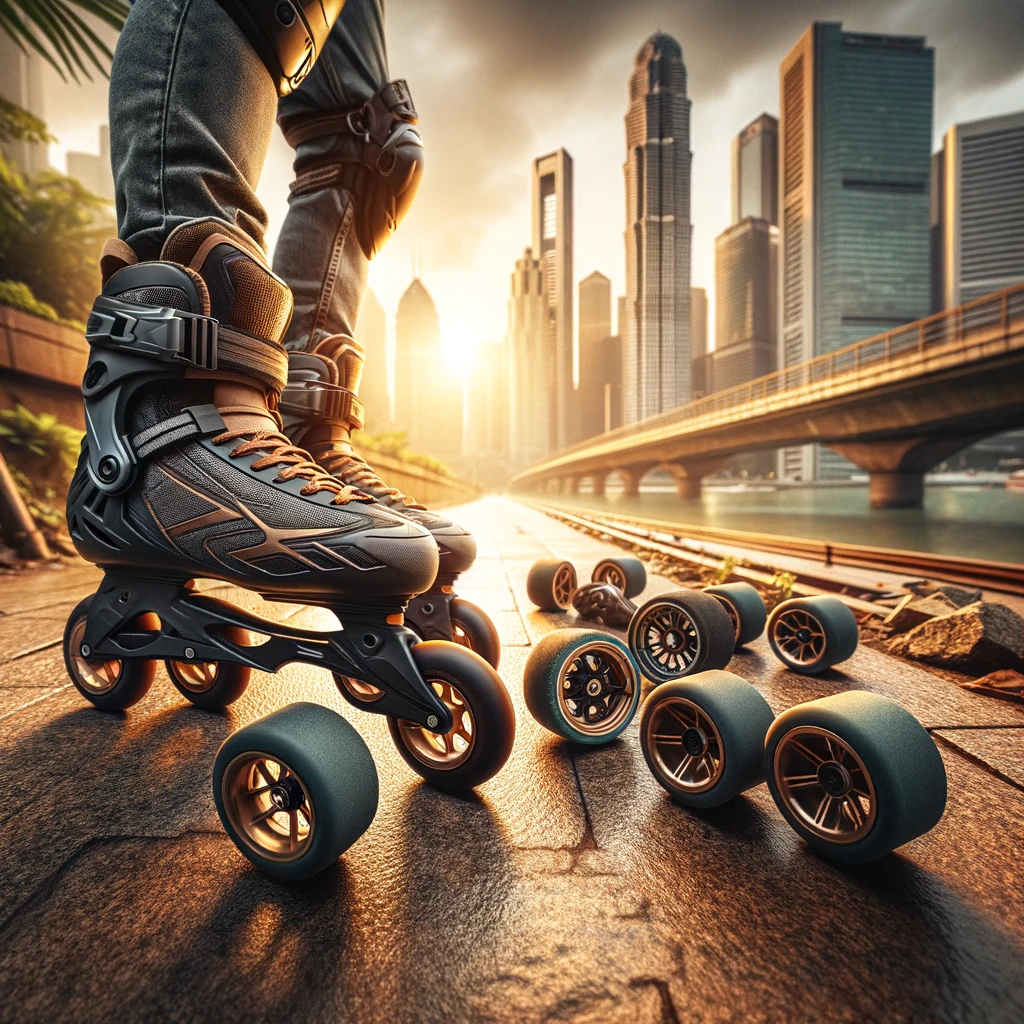Table of Contents
Table of Contents
Introduction
When selecting inline skate wheels, it’s important to consider the skating surface. Each surface demands a specific type of wheel to maximize performance and durability.
We’ll guide you through the aspects that influence your choice, ensuring you enjoy a smooth ride regardless of where you skate.
For indoor skating, we focus on wheels with a harder composition, as they provide better traction on smooth surfaces.
Conversely, outdoor skating surfaces are harsher, requiring wheels with a lower durometer to withstand abrasions and provide longevity.
The wheel size and profile also play pivotal roles. Larger wheels can enhance speed and facilitate longer glides on open pavements, while smaller wheels offer superior control and agility necessary for intricate maneuvers in aggressive inline skating.
Key Takeaways
- Wheel Size: Smaller wheels provide better manoeuvrability, making them more suitable for skating on surfaces that require tight turns. Larger wheels grant higher speeds and are preferred for smoother surfaces where manoeuvrability is less critical. Selecting the right wheel size influences overall performance.
- Wheel Hardness (Durometer): The hardness of inline skate wheels affects grip and durability. Softer wheels, measured at a lower durometer rating like 76a-82a, are best for rough surfaces as they provide better grip. Harder wheels, usually rated 78a-90a, are designed for smoother surfaces for less friction and faster speed. Understanding the durometer is key to matching the wheel to the skating surface.
- Wheel Setup Variations: Most inline skates use a flat setup where all wheels are the same size. Alternate setups, such as Hi-Lo, rockered, or anti-rocker, utilize different sized wheels and are tailored to specific skating styles and surfaces. Getting familiar with different wheel setups provides flexibility and better performance for various skating activities.
- Recommended Sizes for Kids and Adults: Smaller wheels, in the range of 59mm-72mm, are often recommended for kids, particularly for roller hockey, as they suit their lower weight and need for control. Adults playing inline hockey may find the ideal wheel size between 72mm and 80mm. Choosing appropriate wheel sizes for the skater’s age and activity ensures a better skating experience.
JBM Adult & Kids Knee Pads Elbow Pads and Wrist Guards Set for Inline Skating, Roller Skating, Skateboarding and Multi-Sports
(as of 07/25/2024 14:17 GMT +01:00 - More infoProduct prices and availability are accurate as of the date/time indicated and are subject to change. Any price and availability information displayed on [relevant Amazon Site(s), as applicable] at the time of purchase will apply to the purchase of this product.)Understanding Inline Skate Wheels
When we talk about inline skate wheels, we’re discussing a key component that has a significant impact on our skating experience.
Inline skate wheels are primarily made from polyurethane, a material known for its resilience and grip. Unlike PVC, polyurethane provides better performance because of several factors:
- Grip: Polyurethane wheels offer superior traction on various surfaces, reducing slippage.
- Shock Absorption: We feel fewer vibrations because polyurethane wheels can absorb bumps and irregularities better.
- Durability: These wheels resist wear and tear, especially when faced with abrasive surfaces.
It’s important for us to understand that using PVC wheels might compromise our experience. PVC is a harder and less flexible material, which can lead to reduced grip and a higher likelihood of slipping, not to mention a bumpier ride and faster degradation.
Here’s a breakdown of why polyurethane reigns supreme in the realm of inline skating:
Material Quality: Polyurethane
- Superior grip
- Excellent shock absorption
- Long-lasting durability
Material to Avoid: PVC
- Poor traction
- Less shock absorption
- Quicker to wear down
As we gear up for our next skate session, let’s choose the right wheels—polyurethane ones—to ensure the best balance between performance and longevity.
Wheel Size Matters
When choosing inline skate wheels, it’s important to consider the size, as it significantly impacts your skating performance. Wheel size influences various aspects like speed, acceleration, maneuverability, and stability.
Aggressive Skating
For aggressive skating, we recommend wheel sizes between 55mm to 60mm. These smaller wheels reduce the risk of wheelbite during grinds and enhance overall control when performing tricks.
Recreational and Urban Skating
Sizes such as 72mm and 76mm are versatile. They’re often found in rockering setups or in children’s skates. The size offers a balance, providing reasonable speed without compromising too much on control.
Rockering
By using 76mm wheels to rocker an 80mm flat setup, we can achieve an optimal rockering effect for freestyle slalom. This allows for sharper turns and better control, unlocking the potential for advanced maneuvers.
The wheel size choice truly shapes your skating experience.
Larger wheels glide faster and maintain speed more efficiently, they can handle rougher surfaces, but they trade off some agility.
Meanwhile, smaller wheels accelerate quicker and offer greater control for intricate moves, but at the expense of top-end speed.
Choose your wheel size based on where and how you’ll skate, and always ensure compatibility with your skate frame’s specifications.
Choosing Wheels for Different Surfaces
When selecting inline skate wheels for various terrains, we must consider the surface type to ensure optimal performance and durability.
Here’s a breakdown of what wheels work best on different surfaces:
- Smooth Pavement: For a smooth ride on well-paved surfaces, we recommend larger wheels (76mm+). These provide increased speed and better stability which is perfect for fitness skating or long-distance journeys.
- Rough Pavement or Asphalt: Here, medium-sized wheels (72mm-76mm) are ideal. They strike a balance between speed and shock absorption, making the ride smoother over rough terrain.
- Indoor Rinks: Smaller wheels (55mm-60mm) give us the agility needed for indoor rinks. They allow for quick turns and are excellent for performing tricks or playing indoor hockey.
- Gravel or Off-Road: On uneven off-road trails, specialized off-road wheels are necessary. These wheels are made to withstand the challenges of gravel and rough terrain.
- Skate Parks: Skating in parks demands wheels that offer durability and grip. Wheels with a harder durometer ensure they can handle jumps and stunts while maintaining traction.
For each category, specific wheel recommendations can dramatically enhance our skating experience:
- Smooth Pavement: Consider wheels like the Atom Boom Road Wheels.
- Rough Terrain: Wheels such as Matter Image Wheels offer a balanced performance.
- Indoor Rinks: Wheels like the Revision Variant Indoor Wheels optimize indoor play.
- Gravel or Off-Road: Look into Rollerblade Off-Road Wheels for these conditions.
- Skate Parks: Durable wheels like Undercover Grind Rocks are great as they offer the necessary grip and longevity.
Maintenance and Replacement
Maintaining the quality of our inline skate wheels is crucial for a smooth and safe skating experience.
Regular inspection and maintenance help extend the life of the wheels and ensure optimal performance on a variety of surfaces.
Rotation: We must regularly rotate our wheels to promote even wear. Front and rear wheels tend to wear out faster than the middle ones, so swapping them periodically is a good practice.
Cleaning: After skating, especially on dirty surfaces, we should remove any debris from the wheels. A simple wipe with a damp cloth can do the trick. If the wheels are particularly dirty, removing them for a thorough clean may be necessary.
Checking for Wear: Frequent checks on our wheels for any signs of wear is imperative. Look for:
- Flattening on one side or the development of a conical shape.
- Visible reduction in size compared to new wheels.
- Cracks or chunks missing from the wheel surface.
| When to Rotate | When to Clean | When to Check for Wear |
|---|---|---|
| After 10 hours of skating | After sessions on dirty surfaces | Before and after each skate |
| When noticing uneven wear | If wheels are sticky to the touch | When wheel performance declines |
Replacing our inline skate wheels is necessary when certain signs emerge:
- Flat Spots: If we notice any flat spots on our wheels, it’s a clear indication that they need to be replaced as they can cause uneven rolling and discomfort.
- Excessive Wear: Wheels that have worn down significantly or have a significantly reduced diameter compared to new ones will severely affect our ride.
By adhering to these maintenance tips and being vigilant about the state of our wheels, we ensure our skates are always ready for any surface we choose to conquer.


